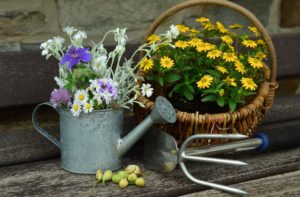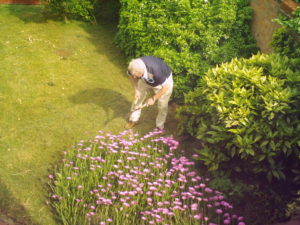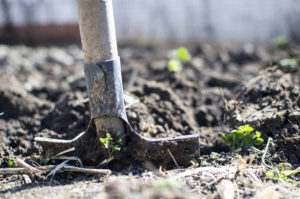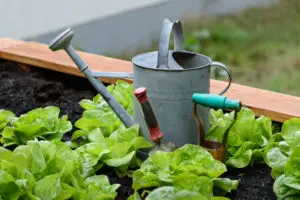These hints will hopefully improve your gardening skills and cause you to be more successful in the arena of growing fruit and vegetables. Let’s take a look.
1. Grow Indoors
For plants that require high temperatures, it might be wise to make use of a greenhouse or poly-tunnel. This is really useful for protecting your plants from frost in the winter months too.
2. Over-watering
If your soil contains too much water then this will be to the detriment of not having enough oxygen which can cause root rot. Your plants will need air if they have any chance of survival.
3. Make your own compost
You can make your own compost if you like. This is easily done by contributing unwanted vegetation, manure, fruit/vegetable cores and peelings, grass cuttings, dead leaves and food wastage. You will need to let this fester and rot for a while until it develops into nutrient rich soil.
Organisms eat away and break down all this stuff into fertilizer. Adding and mixing manure or compost into your plot can actually increase its capacity to hold more water which is useful in preventing water-logging.
4. Repeat Growing
Your land should become more and more fertile every time you try to grow anything season after season because some of the nutrients will always be left behind in the earth.
5. Crop rotation
Changing around the positioning of your crops can help stop the chance of disease in specific parts of the garden. Doing this on a yearly basis would be a good habit to get in to.
6. Beer Traps
Beer is good for tackling snails and slugs. Believe it or not, it turns out the nasty, dirt cheap beer you find in the supermarket is actually useful for something. Leave a container of beer near your crops at night and this will attract any slimy pests.

7. Supports
As your plants grow larger and taller, they should begin to sag to one side. You can remedy this by using garden canes to support them. This is done by connecting the cane and stem together with lengths of string.
8. Pruning
Pruning your produce can often encourage further growth of new shoots which is great if you want to maximize your harvest. This technique is called ‘cut-and-come-again’ in the world of gardening.
9. Washing
Make sure to wash your produce thoroughly before preparing them to eat. You may need to soak them in salty water in order to kill any pests.
If you are growing root vegetables then make sure that you scrub them thoroughly with a nail brush after you’ve harvested them as they can collect a lot of dirt. You can save time washing if you just peel the skin off your produce instead.
10. Soil anchorage
Don’t dig and mix your soil too much or too regularly as this will reduce soil anchorage which will fight against your crops. You ideally want thick, stable soil that will hold against the elements rather than fine, loose soil.
11. Shelter
If you are growing a tall plant then pick out a plot of land that is sheltered from heavy winds so that it won’t be blown over and damaged. You could also additionally install supports which I’ve already mentioned prior.
12. Hardening-off
In order to toughen up your crops it might be a good idea to employ hardening off techniques. This basically means exposing them to low temperatures so that they can build up an immunity or defense against harsh conditions.
You would do this with indoor plants by moving them outdoors and exposing them to the elements once you believe that they’re strong enough.
13. Covering
If conditions are cold then you can warm up the soil by covering the crop with a layer of polythene or fleece in order to help growth. You are looking to form something that looks like a mini-tent which should insulate the whole crop.
14. Manure
Manure is great at making your produce thrive because it has a lot of the nutrients plants need. It is best to acquire manure from animals that eat vegetation rather than meat such as cows and horses as this produces the best results.
You can purchase manure from local farms and garden centers or you could try to hunt some down for free.
15. Drainage
Drainage is important in containers to avoid water-logging and frost in cold weather. Thick soil will struggle to drain itself or retain moisture so try incorporating sand in order to remedy this. You can use grass cuttings and straw to improve moisture retention.
16. Improvised structures
Money can be tight and some people can’t afford to buy full, bonafide poly-tunnels. You can improvise a cheap, small-scale poly-tunnel by laying plastic sheeting over a rigid structure made up of old coat hangers or something similar.
17. Ploughing
Digging in and turning over soil has many benefits. This can include preventing weed growth and letting oxygen in to the earth. You can also get rid of things you don’t want like buried litter, old roots and rocks which will only block roots form anchoring
18. Pre-grown plants
Obviously, some of the work is already done for you if you buy young, pre-grown plants as opposed to growing from seed. This saves time and effort for people who find it too tough to start from scratch. It will speed up and shave time off the process of eventually yielding fruit.
19. STERILIZATION
Cleanliness can help prevent diseases from eating away at your plants. This means implementing sterilized containers and watering with clean water. It’s good practice to wash all your gardening equipment with hot, soapy water after usage.
20. Low maintenance crops
Consider choosing low maintenance fruit and vegetables to grow as this will clearly save you time and you won’t have to worry so much about neglect. This is perfect for the part-time gardener who might be out of home quite often.
21. Netting
You can use mesh or netting to stop birds from pecking away at your produce. Try to get small spaced netting so that you can block out even smaller pests.

22. Freezing
You can freeze some of the produce that you believe that you won’t be able to eat in good time. You may have to blanch some produce before you freeze it as freezing can cause mixed results depending on the foodstuff.
If you have any fresh food that is leftover than you can freeze it and it will last a lot longer. As a result, you could spread it over the rest of the year to use in your meals when the weather for crop growth isn’t so good. It’s mainly just down to being organised.
23. Propagating
Obviously it will speed up the process of growth and fruiting if you propagate from an existing plant rather than starting from scratch and growing from a lowly seed.
24. Thinning out
If you have an old, large and overgrown plant then you may find that it under-performs after a few years. It may be wise to divide it up into smaller separate crops with plenty of space in between. This method is said to make growth even more prosperous.
25. Staining
You would do well to handle produce like beetroot while wearing gloves as these types of colorful vegetables can cause a mess and stain your skin.

26. Ground coverings
You can cover the earth with a layer of straw as this helps prevent weed growth and also absorbs moisture if you’re plot ever becomes waterlogged. You can cover the ground with wood or bark chipping in order to retain moisture and prevent weeds from sprouting up.
27. Careful digging
Be cautious when digging up root vegetables as you can very easily pierce the produce with your fork. I’ve done this so many times with potatoes. It’s advisable to give a wide berth and dig around the area where you think the crops are.
28. Changing the pH
Increasing the alkaline properties of a plot of land can sometimes kill any diseases found in acidic soil and vice versa. Plants grow well depending on the acidic or alkaline tendencies of the soil but you can always change the pH to suit what you want to grow.
If your soil is more acidic than you would like it, then try mixing in wood ashes or bone meal. If it is too alkaline then administer some pine needles, sawdust or peat moss.
29. Storage
Some produce will need to be submerged in water and then refrigerated after harvesting in order to prevent wilting especially in a warm climate.
30. Tomato food
If you ever see any of your crops struggling to thrive then you could always try applying some tomato feed or any other general fertilizer in order to kick-start growth.
31. Discoloration
If you see discoloration in the leaves of your plants then the safest thing to do would be to prune this off as they may be carrying diseases that could spread to other parts of the plant and kill it off completely.
32. Post-harvest ripening
Certain produce will ripen after harvesting if you just leave it sitting somewhere where the sun can hit it like a windowsill for example. This works really well with tomatoes. I know this because I’ve done it many times before.
33. Use a knife
When picking produce it may be better to slice it off with a knife as the twist-and-pull method can potentially damage the rest of the plant. Slicing instead of plucking also encourages further growth as demonstrated by the cut-and-come-again method.
34. Spacing
Generous space between crops is important as a close proximity can negatively affect the growth of both neighboring plants. Too close proximity will mean that several plants will be fighting against each other for growth and sometimes survival.
35. Diversity
Fruit and vegetables cover lots of different food groups so it would be wise to grow a wide variety of different crops in order to give yourself a balanced diet. For example, potatoes contain carbohydrates and fruit has lots of vitamin C.
36. Automated watering
It may be more convenient for some to invest in an automated watering system which can be timed to water your crops on a consistent basis or at a specific time, sparing you the hassle. This can cost a pretty penny but it will save you a hell of a lot of time.

37. Positioning
Try to arrange shorter plants in front of taller ones and not too close together so that nothing gets overshadowed. This way you know that all the plants are getting a good amount of sun exposure.
38. Extra soil
You can boost growth by replacing the top layer of soil surrounding a plant with new compost after a while when you think that it might be struggling.
39. Reflections
A good trick for adding sunlight to your plot is to paint things in your garden white. White is a reflective color so for instance you paint your fence white then light should bounce of and hopefully direct itself to shadier areas.
You can do this with any other garden furniture and you can also install mirrors or shiny panels of metal to perform the same kind of trick.
40. Recycled Pots
You can even recycle an old box or plastic container so you don’t even have to go out of your way to buy plant pots either. Don’t forget to drill a few holes in the bottom so that it can drain.
41. Save your seeds
You can buy seeds once and then not have to buy them again. It’s just a case of harvesting the seeds produced from the first seed and then just keeping repeating that process. Your plants will multiply in no time.
42. Grow more than you need
When thinking about growing a certain food, you should get far more seeds than you think you could possibly need. The reasoning behind this is the fact that a large fraction of seeds will fail to grow.
This could be something completely out of your control and not your fault so don’t worry too much. It is better to have too many rather than not enough.
43. Kick-start your plants
To give yourself an advantage you can refrigerate your seeds during Spring inside a bag or container together with a moist paper towel. This should jump-start them and cause them to sprout which should take 2-3 months.
This is exactly what you want prior to planting and it works particularly well with apple seeds.
They should have finished sprouting and be in the right state at the beginning of the Summer months. This is when the time comes to take them out of refrigeration and plant them properly.
44. Containers stop pests
A good way to prevent pests from doing damage is to plant your seeds in small pots instead of directly into the ground. It’s easier to see what’s going on inside a container of soil instead of a large area of land.
Also, there is a better chance that nothing will creep its way into a container. This is because it creates a decent barrier to stop any creatures from feasting on your produce.
These tips should improve the growth and general quality of your produce. It should also increase the amount of food that you can grow from home. Please don’t forget to share this with your friends and comment below. Thanks for reading!
Sick Of Grocery Shopping? Grow Food In Your Garden & Save Money!
